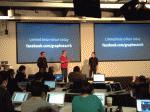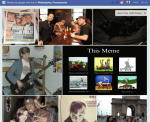
Many of you are probably presented with the same problem when logging into Facebook. The first thing that you see is your News Feed, with tons of content from your friends and pages that you like. Unless you sort your News Feed by recent, which isn’t always accurate, you have no idea what to look at first.
This is a problem for Facebook, because you will probably interact with less content if you’re not shown something that interests you right away. Sure, Facebook has an algorithm based on what you like and who you’re friends with, and with that, they try to show you “relevant” things. It’s not the best, or only possible, solution.
With today’s announcement of Graph Search, Facebook ensures that users will have the chance to interact with all of the content that they missed in their News Feed. If you think about it, if you’re friends with say, one hundred people, it’s unlikely that you’ll even catch 25% of the content that they ever post. The same goes for Twitter, and any other service that displays content in a “stream.”
After performing a simple natural language search with Facebook, I found photos taken by people who live in my home city of Philadelphia:
Of the photos above, I’ve only ever seen one of them, and that’s because I was tagged in it. Yes, we know that Facebook has a wealth of data and some of our most personal moments from the past few years, but the question has always been “What will Facebook do with it all?”
Graph Search is the answer, essentially. Sure, whenever the word “search” gets use, we immediately draw comparisons to Google, which is clearly the leader in the space. When you look at Graph Search, though, you have to look at it through the lens of what it means for Facebook, itself. Even its CEO, Mark Zuckerberg, said he doesn’t expect people to use Facebook as a search engine replacement, but what he probably hopes is that all of those photos, places we’ve been, people we’re friends with and things that we like will become “new” again.
One reason why Facebook purchased Instagram is because it built up a community of people that love to do nothing other than take photos, “like” and comment on them. That engagement is what keeps fresh content coming up in the News Feed.
That’s also why Facebook brought us Timeline, by the way. The massive redesign of your Facebook profile was done to bring all of your status updates back to life, hoping that people would surf it longer, looking at everything in a pretty design, in chronological order. We’re not sure that it’s worked out all that well, because it’s not something that Facebook discusses specifically.
While Google helps you search through the world’s information, Facebook’s Graph Search will help you search through the world you have within your groups of friends. That picture of the moon taken by your cousin on the other side of the country? That’s what Facebook wants to help you unearth, because you probably missed it the first time due to differences in time-zones. Once you find it, you’ll probably like it or comment on it, which will bring it back to life within the News Feed.
If someone posts a really important announcement, like a new job or life event, once it falls off of the News Feed, you may never see it again. That’s bad for users, and it’s bad for Facebook. When Graph Search resurfaces Facebook’s old content, everyone wins.
Real-time isn’t all that it’s cracked up to be, and luckily Facebook has some ideas on how to fix the problems that still keep us disconnected in a connected digital age.


